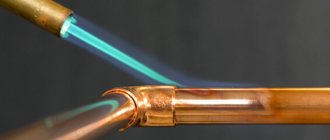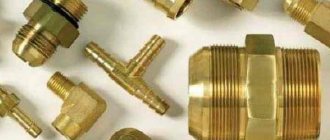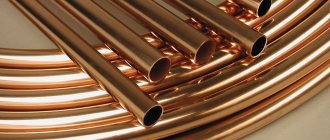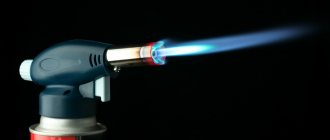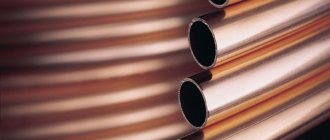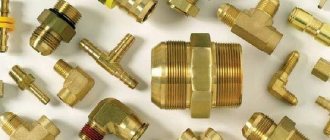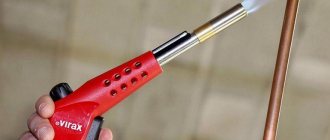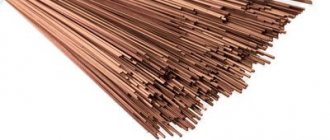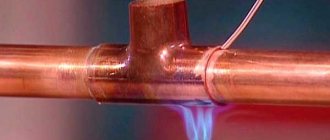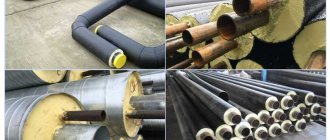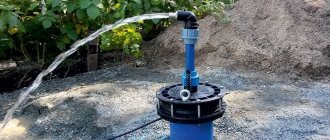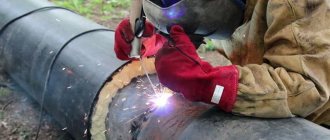Aluminum is the enemy of the split system
The use of an aluminum pipe in the installation of an air conditioner is the worst solution, since in terms of its physical characteristics, aluminum is much inferior to copper in the following factors:
- unlike copper, aluminum is susceptible to corrosion;
- The tensile strength of aluminum is three times less than that of copper.
Pros and cons of copper pipes
Advantages of copper pipes:
- long service life - copper pipelines can last more than 50 years;
- thanks to plasticity, it is possible to produce tubes with a small diameter - if it is necessary to use small tubes in compact products, there is no alternative to copper;
- frost resistance - when the liquid inside the pipe freezes, it will not burst;
- corrosion resistance;
- small dimensions - the tubes have very thin walls;
- resistance to temperature fluctuations;
- UV resistance;
- low permeability to gases - when installing various systems for transporting low-pressure gases, copper products are often chosen;
- when transporting water through copper communications, the concentration of copper in the water does not exceed standard values, the water does not become harmful to human health; copper can be used in medicine and in the food industry;
- chemical inertness;
- operating temperatures up to 100°C;
- the copper walls have a very smooth surface, the pipes are practically not overgrown with deposits of calcium and magnesium salts; have low hydraulic resistance;
- easy recycling - copper can be melted down and reused many times in production;
- pipes can be bent without loss of tightness;
The main disadvantages of using copper pipelines are:
- quite high price;
- restrictions on the working pressure of pipes with large diameters; tubes of small diameters withstand pressure on a par with steel ones;
- operating temperature limitation;
- installation is somewhat more complex than installation of plastic pipelines;
- lower mechanical strength than steel and plastic; the pipe can be crushed, it can be pierced (on purpose; it’s difficult to pierce it accidentally - but there are children with playful hands in every family).
Main factors against using aluminum
Replacing copper pipes in air conditioning systems with aluminum is not only undesirable, but not allowed, let’s figure out why:
- joining of aluminum and copper. Aluminum and copper have different coefficients of thermal expansion, as a result we get depressurization of the system, which leads to freon leakage and incorrect operation of the equipment, while corrosion of the metal forms at the junction of aluminum and copper due to the chemical interaction of these metals.
- freezing of the heat exchanger of the indoor unit, as well as the freon line;
- installation using an aluminum pipe is called “low-quality”; as a result, if the system fails, you will receive a non-warranty case and all costs of restoring the system will have to be compensated at your own expense.
- And if you meet installers who tell you about the huge advantages of an aluminum pipe, then feel free to stop further business with them, you will be the winner, and they will not hit another jackpot.
You should not underestimate the importance of installing a split system, from the most inexpensive to luxury brands; in both cases, 50% of the proper operation of the equipment will depend on how the installation and configuration were carried out, including what consumables were used.
The task of our company is to ensure that you purchase a reliable system that meets all the criteria specifically for you, and also that high-quality installation is carried out using those consumables and materials that are recommended by the manufacturers themselves, and only after that we will be confident that that you will be 100% satisfied after all the work done.
Features of laying and welding
Work on laying copper pipes in air conditioning systems is based on the following algorithm:
- route marking with determination of the location of blocks;
- wall gating or other additional work, if required;
- laying the route.
In most cases, copper pipe for air conditioners is placed in a box. It is important that the location of the drainage channel for condensate removal is sloped. Insulation is performed when it is not present in the original product. Regardless of the type of line - liquid or gas - it must be tightened with plastic clamps.
When the laying is completed and the route is securely fixed, both blocks (internal, external) are mounted. Then they, together with the pipes, are connected into one system, and the joints are checked for leaks.
During operation, it is necessary to periodically check the grip strength of the elements, therefore, in areas with easy access, joining using fittings is used. In places where the sections are joined by soldering, the pipes are first degreased and thoroughly cleaned. After this, liquid or paste flux is applied, then using a torch, the desired areas are evenly heated, and solder is applied. Excess flux is removed after the joint has naturally cooled.
It should be noted that air conditioning copper tubes are simple and easy to install and operate. Annealed elements can be bent at various angles, and the possibility of tearing or deformation of the product is completely eliminated.
Insulation for copper air conditioning pipes - technical specifications
To install an air conditioning system, you need to use copper pipelines. They are best suited for transporting freon. Two pipelines are being laid. Freon enters one in a gaseous state, and the other in a liquid.
Copper is considered the most ductile metal. It is resistant to corrosion processes. This metal is ideal for freon circulation. Soldering and flaring of copper pipes is quite simple.
Therefore, installing such a pipeline is not a technically difficult task. After completion of the installation, high-quality thermal insulation of the air conditioner route is required. This article will show you how to complete this task step by step.
Insulation of pipes in air conditioning systems
Pipe insulation prevents heat loss during air conditioner operation. Rubber insulation has the best efficiency, which, due to its high thermal conductivity, contributes to the reliable operation of the device. Insulation also helps reduce the load on the compressor.
Copper pipe insulation
Rubber insulation requires additional wrapping with nylon tape, which protects the wire from exposure to the sun, as well as from mechanical shock. This tape plays an important role and if it is missing, unpleasant consequences may occur: the insulation may collapse and the compressor may fail.
Why is expensive copper used and not cheaper plastic?
Pipes are used when installing split system routes. Copper is a metal that is practically not susceptible to corrosion processes and is not afraid of temperature changes and direct sunlight. Particularly important is the fact that it does not react with refrigerants, only with the chlorine they contain. As a result of this reaction, a protective layer is formed on the inside of the pipe. Copper tubes for installing air conditioners look very aesthetically pleasing, do not spoil the overall appearance, and last for more than 100 years.
The pipes are highly durable, and cutting, if necessary, is very easy using a pipe cutter. In a word, copper has a lot of advantages over cheap analogues, which is why craftsmen use this particular material in their work.
Price difference
The cost of copper is constantly growing and depends on the exchange rate. The decrease in the quantity and quality of the mined metal, its increasing shortage, contribute to the constant rise in prices for copper products. Therefore, the issue of finding an alternative that can replace copper in the production of air conditioning systems is one of the most pressing.
Aluminum has only recently begun to be used in cryogenic equipment (refrigerators, car air conditioners). The cost is stable and almost three times cheaper than copper; there are large reserves in nature. This opens up great prospects for the industrial production of products from this metal.
Benefits of use
- The aluminum pipe for installing air conditioners bends well, without creases, and requires less effort. The same tools are used as when working with copper.
- low melting point. This makes soldering of elements faster (4 times), significantly saving time, gas, and soldering rods. There is no need for additional equipment, turning seams, etc. The welding seams are much stronger than the metal itself. The blowtorch and gas are the same as for copper.
- due to greater softness, less effort is spent on pipe flaring, the set of tools is the same. The strength of the pipes is ensured by their greater thickness.
- expansion up to 30%.
- thermal conductivity characteristics are almost two times lower than those of copper. This contributes to lower condensation of pipes in the system.
- corrosion resistance is higher, the oxidation reaction rate is lower. This will keep the inside of the cryogenic system pipes clean for a longer time.
- wide temperature range from -80⁰ C to 120⁰ C.
- aluminum pipe for installing air conditioners is lighter, so it can be delivered in 50- and 100-meter coils. This reduces the amount of waste, welding seams and reduces the likelihood of leaks.
Kinds
Pipes for air conditioners are classified according to several parameters.
Main types depending on:
Technologies for their production:
- cold-deformed pipe products;
- pipes for air conditioners made by welding with further hot tempering;
- pressed.
Technological processing:
- hardened;
- hardened;
- semi-hardened;
- anodized;
- artificially aged;
- naturally aged.
Section shapes:
- square;
- rectangular;
- round;
- shaped.
Wall thickness:
- thin-walled (up to 5 mm);
- thick-walled.
Round aluminum pipes
Galvanic corrosion
Previously, the combined use of copper and aluminum was not possible. They form a “galvanic couple” of metals. If they are not connected tightly enough, an electrochemical reaction occurs. Copper oxidizes and corrosion of aluminum occurs. Therefore, when securing with a nut, you cannot use a regular aluminum pipe instead of a copper one. In this case, the connection will not be monolithic, since there is a possibility of destruction of the rolled aluminum pipe, which will inevitably lead to corrosion.
Modern technologies make it possible to solve this problem by producing aluminum pipes with copper tips. Using high-tech equipment, copper is welded to an aluminum tube using intermolecular welding. The result is high-quality material for transferring refrigerant between the external and internal units of the air conditioner at an affordable price.
Sheathed Copper Pipe Rods
Air conditioner installation using copper components
Installing an air conditioner in modern homes is as follows:
- Choosing the location of the outer and inner sides.
- Drilling a hole in the wall with a diameter of 40 mm for laying pipes and cables.
- Installation of fastening of indoor and outdoor units.
- Laying of copper pipes, as well as their insulation.
Insulation increases the efficiency of the air conditioner and prevents moisture from accumulating inside the tubes.
- Cutting copper tubes with a pipe cutter and then flaring the free ends. Copper pipes can only be cut with a special pipe cutter, since a regular hacksaw or grinder can cause small particles to get inside the pipe and circulate through the system. Such particles are especially dangerous for capillary tubes with a diameter of 0.4-0.8 mm.
- Cleaning cut edges.
- Flaring of pipe ends to connect them to the indoor unit.
Flaring the ends of copper pipes
Flaring plays an important role in the reliability of the air conditioner. Correctly performed flaring protects the system from freon leaks.
- As a result of flaring, tubes with attached nuts are obtained.
- Connection of tubes to the indoor unit.
- Exit the pipe to the outside and connect to the external unit.
- Laying a condensate drain pipe.
- Cable reinforcement with special tape.
- Vacuuming the system with a special vacuum pump.
- Disabling the vacuum pump and connecting the air conditioner to the network.
- Checking all units and systems for proper operation.
How to insulate an air conditioner route?
Thermal insulation helps reduce equipment power losses. Some of it may escape through the heat transfer of the pipeline. Thermal insulation helps prevent condensation. The thickness of the insulation depends on the diameter of the air conditioning pipes.
The isolation procedure takes quite a long time. Because it is necessary not only to wrap the pipeline with insulating material, but also to place it in the hole made in the wall.
Completion of the work includes the following stages:
- Calculation of the location of the system. It is necessary to correctly position the copper pipes and air conditioning units. Next, markings are made on the wall to make the task easier. Then the walls are chipped.
- After creating the grooves, they proceed to preparing the route. The pipe coil is unwound to a certain length. Insulation is put on the tubes. It must be purchased in advance in the required volume. To solve the problem more effectively, you need to wrap the air conditioner route with a special Teflon winding tape.
- To equip a long pipeline, soldering of a copper structure is used. It is recommended to avoid breaking the pipeline. This may damage it. As a result, coolant will leak from the system. You need to install the system very carefully.
- The finished route is laid in the channels prepared for it. The pipes are secured using dowel nails and mounting tape. The system must be installed flush.
- After laying the pipeline, the grooves are covered, giving the walls a beautiful appearance. After completing this stage, the air conditioner units are installed, adjusted, and a test run of the equipment is carried out.
After completion of the work, it is necessary to perform pressure testing of the pipeline. To do this, use nitrogen, which is prepared in advance. This stage allows you to avoid accidental breakdown of the structure in the wall. Its implementation makes it possible to avoid possible dismantling work to troubleshoot problems. It is recommended to equip the system with a pressure gauge. Based on its indicators, it is possible to determine the presence and number of existing leaks or their absence.
As an alternative to winding tape, you can use a corrugated pipe of a suitable diameter. It is perfect for laying pipes in grooves. If we are talking about installing a pipeline in a decorative box, there is no point in using a corrugated pipe. It will be more convenient to use winding tape.
Thermal insulation for copper pipes
Copper has many advantages, but the material also has disadvantages. One of them is high thermal conductivity. This property can influence changes in the technical characteristics of the transported medium through pipelines.
Insulation for copper pipes.
It is the thermal insulation of copper pipes that allows you to maintain the temperature of the transported liquid, gas or other substance. Thanks to the heat insulator, for example, hot water will reach its destination without cooling.
Homeowners, owners of apartments, commercial properties, and even tenants of premises often want to carry out hidden installation of utility lines. For this purpose, pipelines are installed in the building structures.
This method allows you to create a planned interior of a certain style in a room. In addition, you will save useful space, which can be used for installing furniture items.
When laying copper pipelines in a wall made of brick, concrete or other material, you also cannot do without insulation. The use of insulation allows you to solve the following problems:
- Avoid the formation of condensation on the surface of communications. Therefore, the plaster or other finishing material will not get wet.
- Protect the surfaces of system elements from the negative effects of concrete solutions, some plaster and putty mixtures.
- Prevent deformation of pipes as a result of shrinkage of the structure or even slight expansion of copper.
Utility networks are often hidden hidden in grooves - these are pre-prepared grooves in brick or concrete walls. After laying the pipeline, the recesses in the building structures are usually sealed with plaster mortar.
How to isolate the route?
To solve the problem, you can use materials from different manufacturers. The most relevant is the following thermal insulation:
K-FLEX insulation is a flexible elastic material. It is made from special raw materials - closed-cell foam rubber. The thermophysical and operational characteristics of this thermal insulation are of high quality. Low thermal conductivity and vapor permeability make the use of this material very convenient. The insulation is durable. It has a high level of sanitary, fire and corrosion safety.
The products are considered one of the best on the market. Its manufacturer has an impeccable reputation among consumers. K-FLEX thermal insulation is one of the most reliable and effective. It is ideal for insulating air conditioner pipes.
Energoflex insulation can also be used to solve the problem under consideration. The range of products of this brand is very wide. The company produces thermal insulation from foamed polymers, especially for air conditioning systems. The material is characterized by a closed-cell surface. It provides a decent level of moisture protection and vapor permeability.
Consumables for installing air conditioners
L-shaped brackets are attached to the outside wall and the outdoor unit of the split system is installed on them. All bracket mounting holes must be engaged. The more powerful and heavier the mounted block, the larger the brackets themselves, and they have a larger number of holes for fasteners. A variety of fasteners can be used for brackets. In standard installation of small household air conditioners, 4 10x100 mm anchors are used. If the facade wall is a complex sandwich structure, for example, brick-insulation-foam blocks, then other types of fasteners can be used.
Copper pipes through which freon will flow connect the outdoor and indoor units of the air conditioner, forming a closed circuit. This circuit must be as tight as possible, since unwanted freon leaks reduce the efficiency of the air conditioner and require frequent refilling of freon. Copper pipes are connected to the air conditioner units using threaded flare fittings. Such connections can become weakened when the street temperature fluctuates throughout the year, as a result of which small freon leaks are possible at the flared pipe joints. In order to avoid the unpleasant consequences of leaks, and not to find yourself in the midst of a heat wave with a non-working air conditioner, it is recommended to carry out annual maintenance.
Air conditioner maintenance is the diagnosis, identification, elimination and prevention of problems in the operation of the system.
Maintenance includes the following types of work:
- Cleaning the indoor unit, including air intake grilles, filters and heat exchanger, antibacterial treatment with a disinfectant compound.
- Check the functioning and, if necessary, clean the drainage system.
- Cleaning the housing and heat exchanger of the external unit of the air conditioner.
- Checking the integrity of the refrigerant flow system, measuring the discharge and suction pressure in the circuit. Elimination of minor leaks in the system and refilling with freon.
- Testing the operation of the air conditioner in all modes, checking the indication of modes.
- Checking the operation of the compressor and fan: identifying extraneous noise, measuring starting and operating currents.
- Control measurements of air temperature at the inlet and outlet of the air conditioner.
The maximum and minimum permissible length of the copper pipeline for interunit communication is indicated by air conditioner manufacturers in the operating manual.
In any case, the length of the freon pipe should not be less than three meters for household models of air conditioners; you definitely need to pay attention to this. There is also such a term as an oil lifting loop. A loop is required when the height difference between the indoor and outdoor units is more than 5-7 meters. For household series, such a case is rare, but sometimes it does occur. For semi-industrial and industrial air conditioners, large height differences are more common.
The correct oil lifting loop should be made with a small radius and have a small depth, that is, it should create a plug of oil, but not accumulate a large amount of it. Copper pipes should only be cut with a special tool - a pipe cutter. After cutting, the end of the copper pipe must be processed with a rimmer. This is a device for removing burrs and smoothing pipe surfaces after cutting. A smooth end surface of the pipe is necessary for high-quality rolling and ensuring high tightness of the joints.
In order for the air conditioner to work properly, copper pipes along the entire length must be thermally insulated, including where they pass through the wall.
The thermal insulation of the air conditioner is made of synthetic rubber and is supplied in two-meter tubes. It comes in black and gray, but the color does not affect the thermal insulation properties. It is used to prevent heat loss and the formation of condensation on the surface of air conditioner tubes.
Attention! Make sure that the freon pipes passing into the hole in the outer wall are also thermally insulated! A common mistake is when thermal insulation is stretched over external and internal copper pipes only up to the hole in the wall. This method of thermal insulation of freon communications is allowed only as a last resort: when it is impossible to drill a hole of the required diameter with a large concentration of reinforcement in the facade wall (usually happens in the lower floors of multi-apartment high-rises). In this case, the freon tubes in the wall itself remain without thermal insulation, and the hole in the wall is foamed with polyurethane foam. When air enters a hole in the wall, condensation will begin to form on the tubes over time, which will flow into the wall. And since walls always have microcracks and pores, whether they are brick or concrete structures, sooner or later, streaks or dark spots of mold may appear on your walls.
The nuts connecting copper pipes to the indoor unit of the air conditioner are also subject to thermal insulation to prevent the formation of condensation. It happens that in order to facilitate fixation of the indoor unit on the mounting plate, unqualified installers violate the integrity of the thermal insulation in the indoor unit. The thermal insulation in the indoor unit is made of foam plastic and its damage can also lead to the formation of condensation and stains on the walls.
Copper pipes, insulation, drainage hose and electrical cable together form a freon pipe, or “trace”.
Before the assembled freon pipe is passed into the hole in the outer wall, the copper pipes must be closed with plugs at the ends. This prevents construction dust, sand, dirt, etc. from entering the pipes. Otherwise, when you first start the air conditioner, dirt will inevitably get into the compressor, and the consequences will be about the same as if you pour coarse sand into a car engine: the air conditioning compressor will very quickly fail.
- Copper tubes must be completely insulated along their entire length, without breaks. Proposals from installers to pass bare copper pipes and foam the hole with mounting foam and thereby “thermally insulate” the copper pipes are categorically not accepted!
- To create a single thermal insulation cover, the joints of the thermal insulation sections must be wrapped with hydrous tape.
- Fastening external communications. Communications (tubes, cables) passing along the street wall must be securely fastened. The installer must secure the communications to the outer wall at least at one point, since in strong winds the unsecured communications sway and the copper tubes in the rolling areas on the external unit may burst. This will cause freon to leak from the air conditioner.
- Communications laid on an external wall in an open way must be wrapped with reinforced tape or Teflon tape so that the thermal insulation of copper pipes does not deteriorate under the influence of the environment. If the street part of the communications is placed in a decorative box, then continuous wrapping with adhesive tape or Teflon tape is not necessary.
A decorative box is used when installing the indoor unit of an air conditioner in order to hide the route indoors. A box of standard size 60x60 mm is usually used. If communications will take place in a decorative box, then the gaps between the box and the indoor unit are sealed with white silicone sealant or closed with special plastic covers.
It is advisable to use a drainage hose that is corrugated, solid (without breaks), with a rigid plastic spiral. The attachment point of the outdoor drainage hose with the drainage hose from the indoor unit must be secured with electrical tape and a metal clamp. The slope of the drainage pipe must be at least 1 centimeter per 1 meter of length (more is better, less is unacceptable!). The drainage hose must be securely attached. It is advisable to firmly fix the drainage hose every meter of length to prevent sagging and the formation of all kinds of loops in which condensate can stagnate. When sagging appears in the drainage system, water plugs form and condensation from the internal unit of the air conditioner has nowhere to drain except into the room - along the wall, wallpaper, onto the floor or upholstered furniture.
Important! After installing the air conditioner, installers must test the drainage system. To do this, water is poured into the drainage pipe from the side of the indoor unit, and the free flow of water to the street is checked. If this is not done, you should ask the installer to demonstrate the permeability of the drainage system. This will require no more than 2 minutes and 0.5 liters of plain clean water. And in the future it will help save you time and nerves.
When choosing a location for installing the air conditioner, it is necessary to take into account that the section of the wall on which you plan to mount the indoor unit must be strong and capable of supporting the weight of the split system units. There must be unhindered air circulation around the indoor unit. The gap between the top panel of the indoor unit and the ceiling must be at least 170 - 200 mm. The indoor unit is mounted using the mounting plate included in the delivery kit. The mounting plate is attached to the wall using screws and is fixed to the wall strictly level. In this case, normal removal of condensate formed during operation of the air conditioner is ensured. The indoor unit must not be placed near sources of heat and humidity, and the unit must not be installed near a doorway. There should be no obstruction to the air blown out of the indoor unit. It is advisable to leave free space near and below the indoor unit for servicing.
There must be enough free space around the outdoor unit of the air conditioner for effective heat exchange. Warm air must be discharged in such a direction as not to cause inconvenience to neighbors. The outdoor unit must be mounted on a flat, solid base. The distance to the nearest obstacle should be at least 500 mm from the front side and at least 400 mm from the sides of the outdoor unit.
Vacuuming is the final and one of the most important stages in the installation of air conditioners! The name of the operation speaks for itself - a vacuum is created in the air conditioning system by pumping air from the freon pipes and the indoor unit.
What does ignoring this operation entail?
The freon (refrigerant) contained in each outdoor unit also contains oil to lubricate the compressor. This oil is extremely hygroscopic, that is, it can absorb moisture, including from the air. If evacuation is not performed, then in the sealed system (outdoor unit - freon tubes - indoor unit) air saturated with moisture will remain, and over time the compressor oil will lose its technological properties. The oil will no longer lubricate the moving parts of the compressor, which may cause premature failure of the compressor.
Since a vacuum pump is not a cheap piece of equipment, careless installation crews find a way out of the situation - they blow the system with freon contained in the outdoor unit.
Soldering copper pipes using copper-phosphorus solder
If the burner flame is bright blue and medium in size, then this indicates that the gas mixture contains equal amounts of oxygen and gaseous fuel. Thanks to this soldering, the metal will heat up evenly.
If the burner flame is small and pale blue, this means that there is a lot of oxygen in the gas mixture. During such soldering, the surface of the metal will oxidize, as evidenced by the appearance of a dark coating on the metal.
The guarantee of the reliability of the solder joint is the preparation of the copper surface. It must be free of dirt, oil, paint and other substances that may interfere with the application of solder to metal surfaces.
When connecting two copper pipes by soldering, it is necessary to ensure that the following conditions are met:
- a pipe with a smaller diameter must fit into a pipe with a larger diameter no less than the length of its diameter;
- the gap between the walls of the outer and inner pipes should be in the range of 0.025-0.125;
- heating is carried out evenly along the entire length and circumference of the connection;
- using the correct size burner with decreasing flame. When overheated, the base metal begins to interact more strongly with the solder, as a result, such a connection will have a significantly shorter service life.
Solder will not distribute evenly between the pipes being joined when the inner pipe is hotter than the outer pipe and vice versa. It is necessary to completely and uniformly heat the entire surface of the pipes being welded, only in this case will the solder evenly penetrate into the joint gap.
If the brazing rod melts from contact with heated pipes, this means that they are sufficiently heated. To improve the soldering process, the brazing rod is preheated with a torch flame.
It is known that solder penetrates into pipe joints under the action of capillary forces, and in order to facilitate the process of its spreading, it is necessary to first take care of the cleanliness of the surface of the joints being welded and maintain the required gap. You should also remember that the solder always moves towards the heat source.
Copper pipe size chart for air conditioners
| Size in inches | Size in mm | Manufacturer | Availability | Selection of insulation |
| Copper pipe for air conditioners 1/4 inch | 6,35 | Serbia, Germany, Russia | in stock | Energoflex 6x6 K-Flex 6x6 |
| Copper pipe for air conditioners 3/8 inch | 9.52 | Serbia, Germany, Russia | in stock | Energoflex 6x10 K-Flex 6x10 |
| Copper pipe for air conditioners 1/2 inch | 12.7 | Serbia, Germany, Russia | in stock | Energoflex 6x12 K-Flex 6x12 |
| Copper pipe for air conditioners 5/8 inch | 15.88 | Serbia, Germany, Russia | in stock | Energoflex 6x15 K-Flex 6x15 |
| Copper pipe for air conditioners 3/4 inch | 19.05 | Serbia, Germany, Russia | in stock | Energoflex 6x20 K-Flex 6x20 |
| Copper pipe for air conditioners 7/8 inches | 22.22 | Serbia, Germany, Russia | in stock | Energoflex 6x22 K-Flex 6x22 |
Selection of pipes for air conditioner
Copper pipes for air conditioning systems are selected according to the following parameters:
Types of pipes for air conditioning
Industrial enterprises produce two main types of copper pipes:
- annealed or soft;
- unannealed or hard.
Annealed pipes have the following parameters:
- strength in the range of 210 - 220 thousand kPa;
- elongation at break 50% – 60%.
Annealed pipes are mainly manufactured in lengths from 15 to 50 m, supplied in coils and are characterized by high flexibility and low ability to deform.
Heavy Duty Air Conditioner Pipes
Unannealed pipes have the following characteristics:
- strength 280 - 300 thousand kPa;
- elongation at break 10% – 15%.
Copper pipes of this type are usually supplied in rods, the length of which does not exceed 5 m. To protect the internal part from dust and other contaminants, special plugs are installed at the ends of the pipes.
Pipe made without additional annealing
Selection of pipe sizes
When determining dimensions, the most important parameter is the diameter of the copper pipe for the air conditioner.
Currently, copper pipes with a diameter of 6 mm to 100 mm are produced.
Standard pipe sizes and their technical characteristics
For air conditioners, pipes with a diameter (in inches) are mainly used:
- 3/4;
- 1/4;
- 1/2;
- 3/8;
- 5/8.
Russian aluminum pipes
Today, Russian manufacturers offer high-quality aluminum pipes for the installation of cryogenic equipment. They are cast from AD0 metal. This alloy consists of 99% aluminum, weldable, and is characterized by high corrosion resistance and sufficient strength. Manufacturers give it a several-year warranty and specify a service life of 15 years.
Reviews indicate that Russian-made aluminum pipes differ from their Chinese counterparts in the higher quality of raw materials, which affects their resistance to corrosion during operation.
Copper pipes according to GOST 32598-2013 for water supply and heating systems
The GOST 32598-2013 standard establishes the range (dimensions), technical requirements, control methods, and acceptance testing of copper pipes intended for water supply systems for water and steam heating.
Dimensions of copper pipes according to GOST 32598-2013
The table shows the recommended values for the diameter and thickness of copper pipes for heating.
Designation of pipes according to GOST 32598-2013
The pipe designation according to GOST 32598-2013 indicates the same data as according to the EN 12735-1 standard, in addition there is additional information. The pipe marking should indicate:
- Manufacturing method (D - drawn);
- Shape (KR - round);
- Condition (M - soft, for an annealed pipe; P - semi-hard; T - hard, for an unannealed pipe);
- Dimensions (Outer diameter x wall thickness x length);
- Delivery form (piece, coil, BT - free winding coil, BU - ordered winding coil, BS - spiral winding coil - BS);
- Brand of copper;
- Standard.
The designation diagram is shown in the figure.
Example notation
To designate an annealed copper drawn pipe, round cross-section with a diameter of 10 mm, a wall thickness of 0.8 mm, made of M1r grade copper, the marking is used:
GOST, TU and other standards.
The technical conditions of a copper tube for air conditioners are determined according to GOST 617-2006, TU184450-106-181-2006 and TU 48-21-769-85. High precision manufacturing and finishing of copper tubes for air conditioners is regulated by GOST 26877-2008 Metal products. Methods for measuring shape deviations. Grades of primary copper must comply with GOST 859-2001. The chemical composition of copper and alloys is determined according to GOST 13938.1 - GOST 13938-15, GOST 9717.1 - GOST 9717.3, GOST 1652.1 - GOST 1652.13, GOST 9716.1 - GOST 9716.3. For each imported grade European EN12735-1. and the American ASTM B280 standard, you can select a domestic brand according to GOST 859-2001.
Installation of copper pipes for air conditioners
Installation of pipelines between the external and external units of the air conditioner is completely doable with your own hands. If you purchased annealed pipes of the required length, then installation is carried out without welding.
Required tools and materials
To install copper pipes you will need:
- pipe cutter for copper pipes or hacksaw;
- flaring;
- file, sandpaper;
- FUM tape;
- spanners and gas wrench;
- rags.
- A pipe bender will come in handy - it will allow you to carefully bend pipes without wrinkles or deformations.
Precautionary measures
Be sure to wear safety glasses when cutting and stripping copper products.
Before filling the air conditioner with freon, be sure to check the operation of the system filled with air. Coat the joints with soap foam, turn on the air conditioner and let it run for a few minutes - the leak will be visible.
Work progress
The work is carried out after installing the air conditioner. First, carefully measure the distance from the external to the internal unit. The pipe is cut to a large margin in length. Thermally insulated products are cleaned of insulation at the ends. Insulation is put on uninsulated pipes.
Then carefully clean the ends of the pipes from burrs. Place union nuts with threads so that the threads are flush with the end of the workpiece. They are flared using a special device - flaring. This work must be done carefully - it is impossible for cracks, waves and folds to form on the tubes. The result is a reliable sealed connection between the nut and the tube.
Secure the pipeline to the fitting of the outdoor unit using a nut. Do not clamp the connection too hard - you can damage the tube.
Then the pipelines are placed inside the room and hung on brackets. Tubes for air conditioners are flexible, they can be bent if necessary simply by hand. With the help of a pipe bender, turns will be more accurate.
Then it is necessary to repeat all operations (cutting, deburring, flaring) and secure the pipeline to the indoor unit.
Installation features
The tubes must be insulated - for this there are all kinds of ready-made covers made of foamed polyurethane or polyethylene, sometimes coated with a layer of foil. Condensation will settle on an uninsulated pipe and drip onto the furniture. If the length of the communication is more than half a meter, then it is necessary to install special fastenings.
Professional thermal insulation of air conditioner pipes
Thermal insulation of pipes is necessary to insulate them and protect them from condensation.
The insulation material should have increased strength, but at the same time be easy to cut and fit neatly to the pipe along its entire length. Proper installation of thermal insulation will help maintain the air conditioner's performance at the proper level. provides the following services:
- sale and delivery of air conditioning systems from the best manufacturers;
- installation work of varying complexity;
- maintenance and repair of climate control equipment.
The company fulfills large orders in a short time, and free delivery is possible. Product quality is confirmed by certificates of compliance with state standards. When making a purchase, a manufacturer's warranty is issued for air conditioners and other climate control equipment.
If you have any questions, call the phone number listed on the website and our managers will provide you with qualified assistance.
